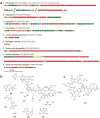Complete genome sequence of the plant commensal Pseudomonas fluorescens Pf-5
- PMID: 15980861
- PMCID: PMC7416659
- DOI: 10.1038/nbt1110
Complete genome sequence of the plant commensal Pseudomonas fluorescens Pf-5
Erratum in
- Nat Biotechnol. 2006 Apr;24(4):466
Abstract
Pseudomonas fluorescens Pf-5 is a plant commensal bacterium that inhabits the rhizosphere and produces secondary metabolites that suppress soilborne plant pathogens. The complete sequence of the 7.1-Mb Pf-5 genome was determined. We analyzed repeat sequences to identify genomic islands that, together with other approaches, suggested P. fluorescens Pf-5's recent lateral acquisitions include six secondary metabolite gene clusters, seven phage regions and a mobile genomic island. We identified various features that contribute to its commensal lifestyle on plants, including broad catabolic and transport capabilities for utilizing plant-derived compounds, the apparent ability to use a diversity of iron siderophores, detoxification systems to protect from oxidative stress, and the lack of a type III secretion system and toxins found in related pathogens. In addition to six known secondary metabolites produced by P. fluorescens Pf-5, three novel secondary metabolite biosynthesis gene clusters were also identified that may contribute to the biocontrol properties of P. fluorescens Pf-5.
Conflict of interest statement
The authors declare no competing financial interests.
Figures



Comment in
-
Biocontrol genome deciphered.Nat Biotechnol. 2005 Jul;23(7):823-4. doi: 10.1038/nbt0705-823. Nat Biotechnol. 2005. PMID: 16003366 No abstract available.
References
-
- Haas D, Keel C. Regulation of antibiotic production in root-colonizing Pseudomonas spp. and relevance for biological control of plant disease. Annu. Rev. Phytopathol. 2003;41:117–153. - PubMed
-
- Raaijmakers JM, Vlami M, de Souza JT. Antibiotic production by bacterial biocontrol agents. Antonie Van Leeuwenhoek. 2002;81:537–547. - PubMed
-
- Weller DM, Raaijmakers JM, Gardener BB, Thomashow LS. Microbial populations responsible for specific soil suppressiveness to plant pathogens. Annu. Rev. Phytopathol. 2002;40:309–348. - PubMed
-
- Howell CR, Stipanovic RD. Control of Rhizoctonia solani in cotton seedlings with Pseudomonas fluorescens and with an antibiotic produced by the bacterium. Phytopathology. 1979;69:480–482.
Publication types
MeSH terms
Substances
Associated data
- Actions
LinkOut - more resources
Full Text Sources
Other Literature Sources
Molecular Biology Databases
Miscellaneous

